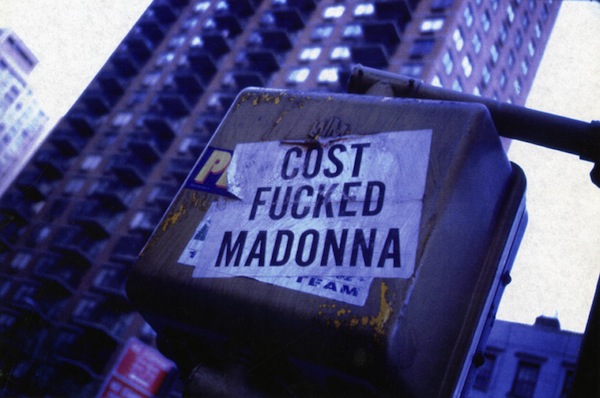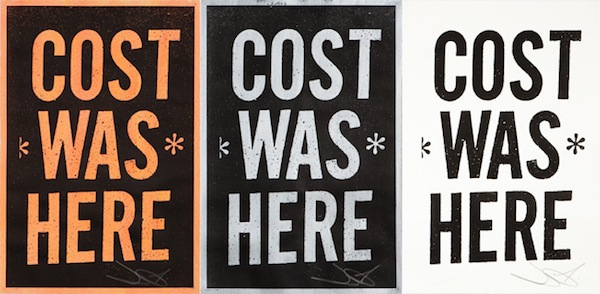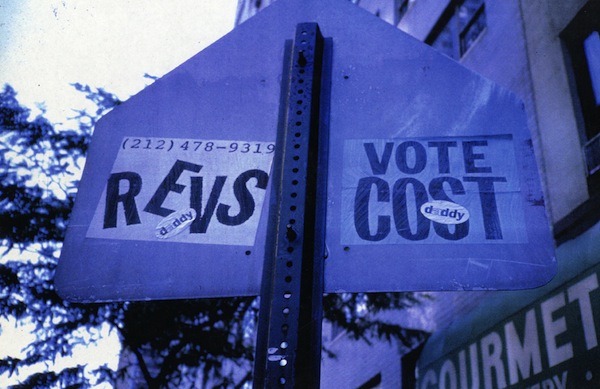
In just a few hours, Papermonster will be releasing a new series of ink relief prints from graffiti legend Cost: The COST WAS HERE series come from iconic posters that covered the streets of New York City in the 1990’s. There will be three prints in different colorways (orange, silver and white), each editions of 30 and 16.75 x 24.75 inches. I love that Cost picked this particular phrase for the prints. What’s more graffiti than trying to say that you were somewhere? And if Cost doesn’t actually have to be there himself but can rely on others to spread his name for him, all the better.
Check them out:

These go on sale at 10am Eastern on Friday at Papermonster’s webstore, and they will each cost $150.
And if you don’t know Cost’s history or just need a little refresher (or, like me, you weren’t there so you need to hear things secondhand), here’s some words by Ian Bourland on Cost and his writing partner Revs:
COST was there. It’s difficult to imagine New York City (to say nothing of its global imitators) without street art bedecking every nook and cranny. The streets of Williamsburg and SoHo are wheatpasted, stenciled, and stickered, old-school throwies and bubble letters cheek-by-jowl with corporate-sponsored attempts to capitalize on the popularity of artists like Banksy and Shepard Fairey. But a mere twenty years ago, what is now commonplace was virtually unheard of. During the early years of the Giuliani administration and the twilight of old school train car graffiti, COST and his partner in crime REVS revitalized aerosol art’s core mission even as they opened the door for a generation of street artists to follow.
During the late seventies and early eighties, New York experienced an efflorescence of street art: on the one hand, crews of aerosol writers bombed the city and its subways with increasingly elaborate style and intricacy; on the other, Jean-Michel Basquiat and Keith Haring served as crucial links between the downtown gallery scene and the streets, writing on walls and subway platforms in bold, easily-recognizable text and linework.
COST was of a generation younger than the likes of Basquiat, Lee, and Seen, but growing up on the streets of the East Village he absorbed their influence, as well as the DIY ethos and graphic influence of the punk rock subculture centered around CBGB. The hand-painted works he would later wheatpaste around the city featured figures reminiscent of Haring’s “radiant children,” and his own arrow-laden tags. In COST’s terms, he took all the came before, all the was forged in the welter of downtown, and “mixed them in his paintbucket.”
The results were iconic, and give us a window into an often-overlooked history of street art. In the face of an increasingly ornate and unwieldy style of graffiti and a hostile mayoral regime, COST and REVS aimed to strip graffiti back to its roots: getting over and reclaiming urban space. He recalls that, “in the early nineties I was frustrated and upset with the direction that graffiti was going once it officially moved above ground after the train era died out…We began to incorporate and emphasize the philosophies of non-perfection to an art form that had steadily moved towards a state of perfection. The focus became more on involving ourselves within the everyday landscape—we were doing outlaw art, and it was for everyone to see, from a child to your grandmother.”
This outlaw art required a new set of rules, and a new approach to medium. Spray cans and caps took a less central role, and COST and REVS pioneered now familiar tools such as heavy rollers, stickers, stencils, and wheatpasting prefabricated work to any urban surface that would bear it. During the first half of the nineties COST and REVS took the drive to “get up” to a new extreme, diffusing their work across the CIty in ways earlier generations could only imagine.
Walking around downtown Manhattan in those days, you could spot a wheatpasted painting in a brick inset on the backstreets of SoHo, rolled tags on fourth floor walkups off Lafayette street, murals around Tompkins Square Park, and their ubiquitous, sans-serif stickers. Some of these were simple and declarative: “COST Fucked Madonna;” other recalled the interactive and politicized spirit of both Fluxus and the hardcore scene—dial the number on a COST sticker, get the rant of the week about Rudy Giuliani. In this way, COST served as a crucial bridge figure, a link to graffiti’s golden age and street art’s future. The mural “Mt. Krushmore,” depicting Andy Warhol and Keith Haring in blown-up photorealism, synthesized the grand scale and aerosol style of the eighties with the graphic sensibilities of the present. That piece, towering over the East Village, was up for several years. Nowadays, more familiar names might occupy the walls downtown, but make no mistake: COST was here.

Photos courtesy of Papermonster
